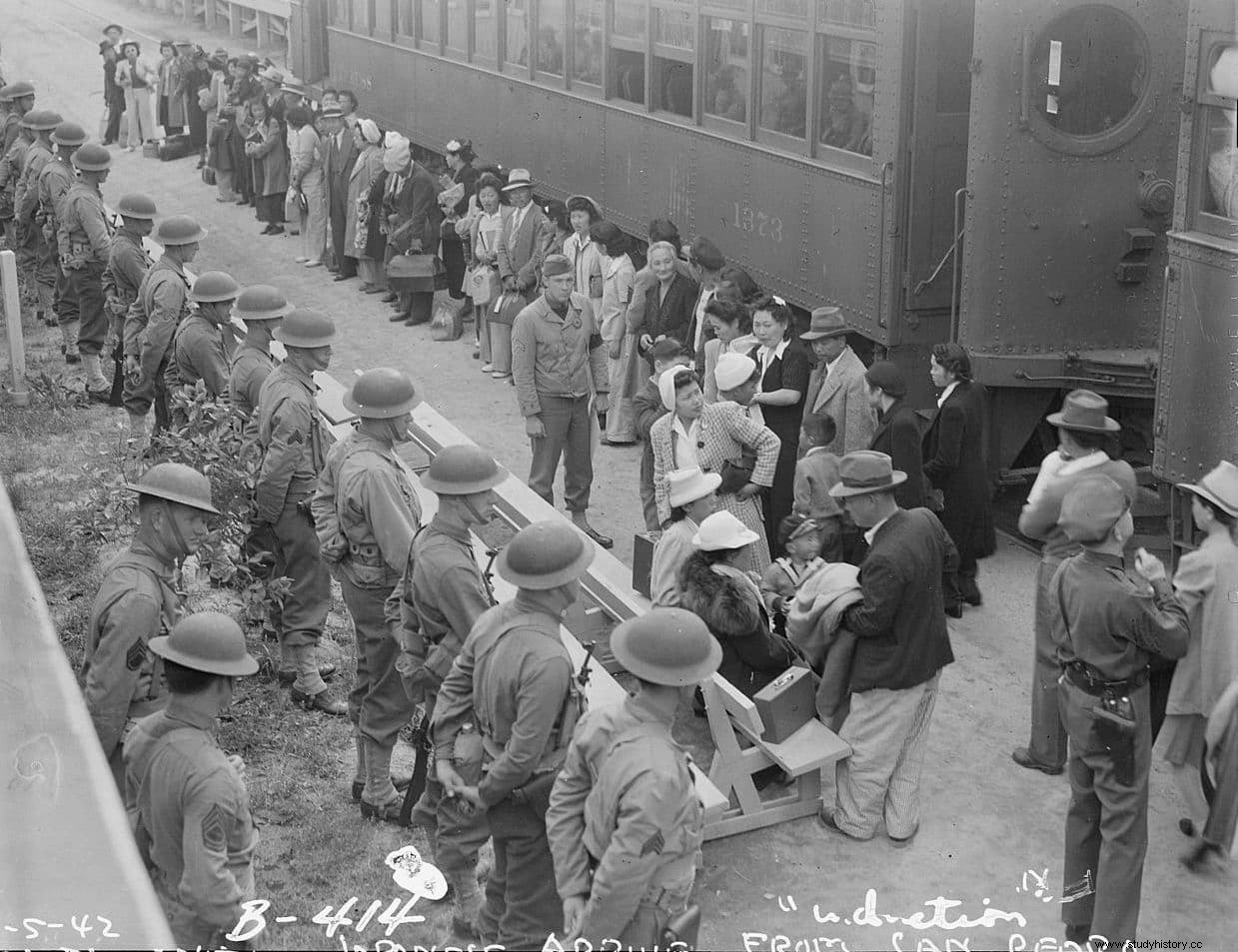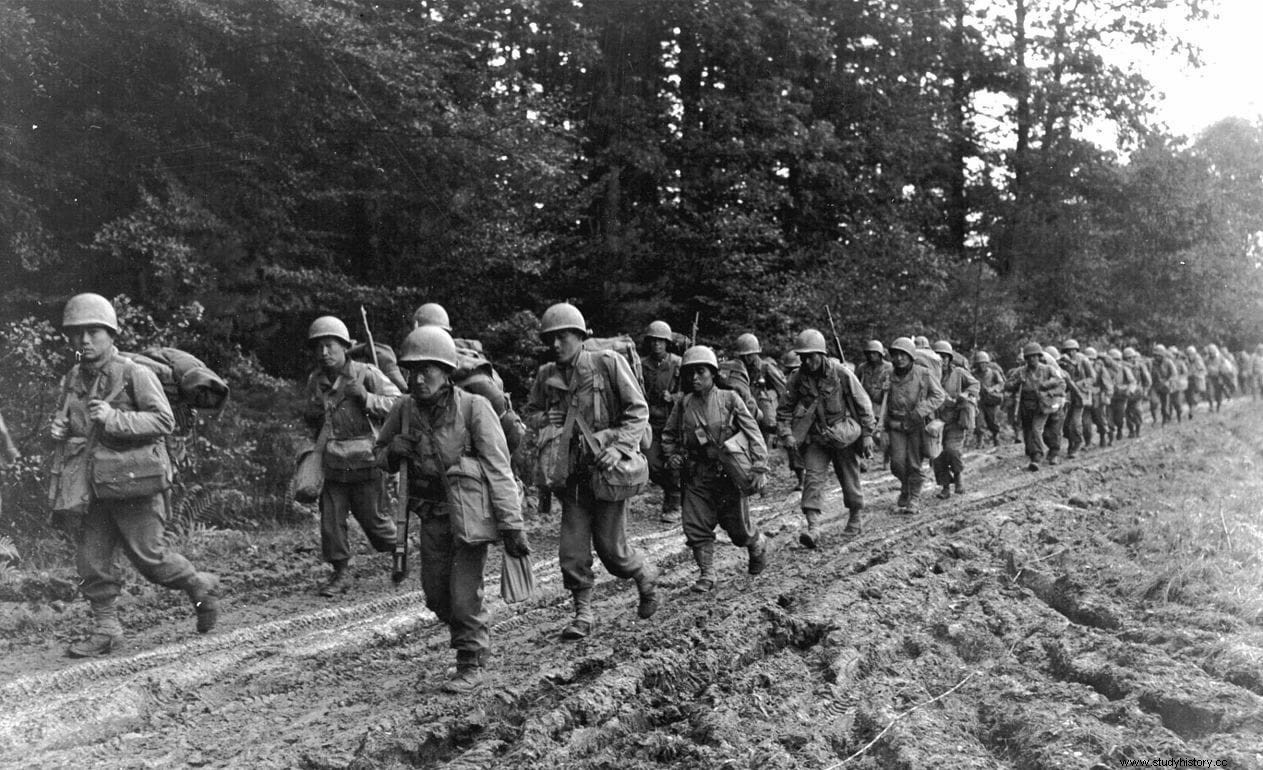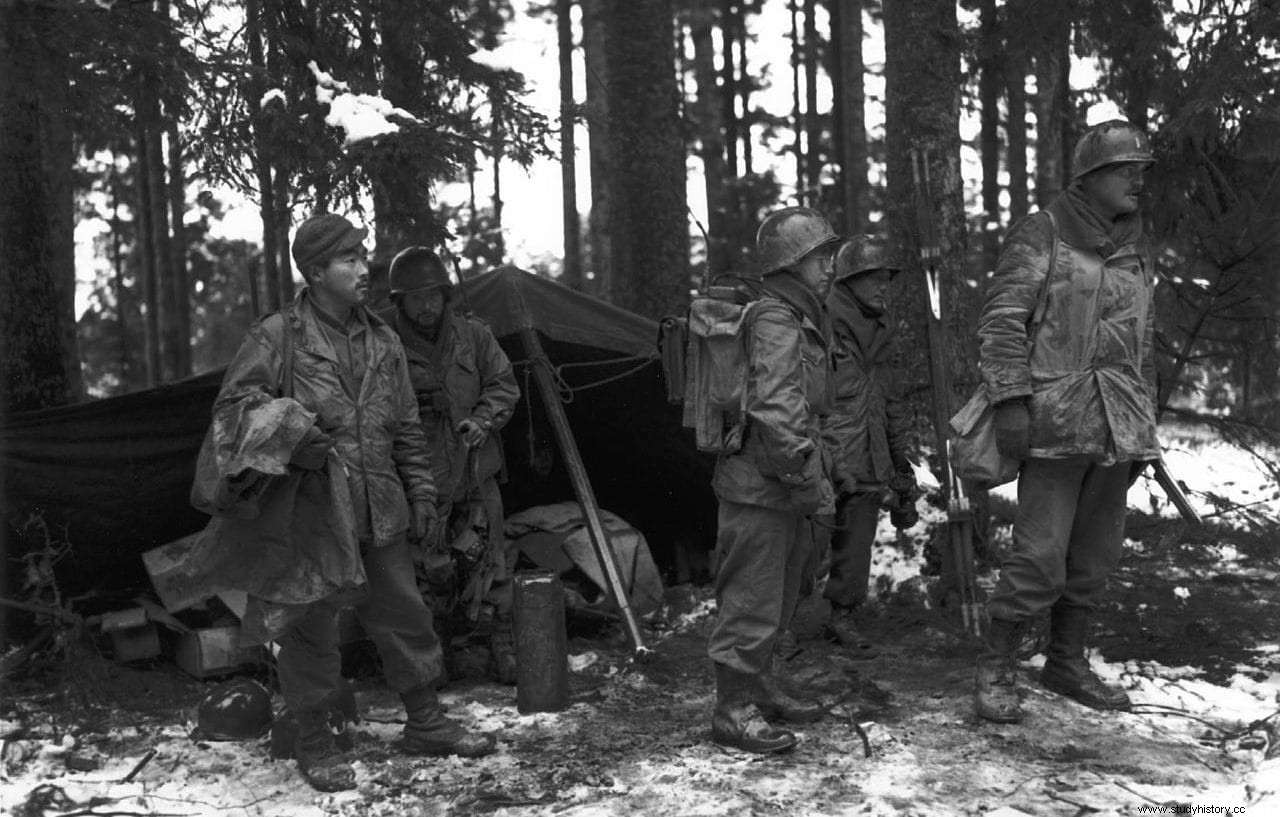Who has seen the famous movie Karate Kid , you may remember a scene in which Mr. Miyagi evokes the memory of his late wife, who died giving birth to her child while he was at the front during World War II. The curious thing is that he did not fight in the Japanese army but in the US, which is surprising at first because the nisei (Americans of Japanese origin) were interned in concentration camps in 1942. But it is that Mr. Miyagi, as shown in The new Karate Kid (the fourth film in the saga), was part of the 442nd Infantry Regiment, a body created precisely with nisei soldiers volunteers, who became the most successful in the country's military history.
On February 19, 1942, less than three months after the attack on Pearl Harbor and the consequent entry of the United States into the global war, President Roosevelt authorized his War Department to create concentration camps for the nearly one hundred and twenty thousand inhabitants of oriental ancestry registered in the national census as potential suspects of collaborating with the enemy. To do this, facilities were built at various points on the West Coast and, following Executive Order 9006, the FBI proceeded to arrest members of the Japanese community; at first only to their leaders, but a new order, 9102, extended those confinements to everyone.
There were some one hundred and twelve thousand people who had to leave their homes and sell off both their properties and their businesses to move to the indicated centers, despite the fact that two thirds had already been born in the United States. The process was completed in just two weeks except in one place where it was virtually impossible to implement:Hawaii. That was because a quarter of the population was nisei and many citizens of that category constituted not only an essential labor force, as the insular businessmen noted, but also held important civil service positions. Doing without them would have been an economic catastrophe.

What was done was to discharge all the members of the Hawaii Territorial Guard , a local version of the National Guard made up of students and reservists from the ROTC (Reserve Officer’s Training Corps ), organized shortly after the attack and intended to monitor facilities. However, they requested to collaborate in the defense and it was granted, organizing them in the Varsity Victory Volunteers , a unit of sappers assigned to the Schofield Barracks base and which, having been banned from combat, received the mission of carrying out engineering tasks:construction of roads, fencing, erection of military architectural structures, etc. They received no salary and, although they were housed separately from the rest of the troops, they quickly gained their trust.
Instead, the eastern members of the National Guard proper, some 1,300 soldiers who were enlisted in the 289th and 299th infantry regiments, were allowed to remain in ranks, since otherwise the available forces in the archipelago would have been seen dangerously diminished. Of course, it was decided to bring them all together in the same body, exclusively made up of nisei , which was christened the Hawaiian Provisional Battalion (Provisional Hawaiian Battalion). On June 5, he embarked for the continent to receive the corresponding training at Camp McCoy (Wisconsin); ten days later it received its new official name:100th Infantry Battalion, popularly nicknamed One Puka Puka .

Some of its members won the first medals already in that seminal period, by rescuing civilians from a frozen lake. They seemed determined to respond to trust and erase any suspicion, to the point that they adopted Remember Pearl Harbor as their motto. . Six months later, in January 1943, they completed their training at Camp Shelby, Mississippi, and Camp Clairborne, Louisiana, and then became part of a newly minted regiment that was joined by another 800 nisei continental. It was June 1943 and the 442nd Infantry had just been born, commanded by veteran Colonel Charles W. Pence.
The recruitment was not without incident, of which the most significant was the double refusal to answer that a quarter of the candidates to enter gave to some previous questions about their loyalty to the United States and their commitment to renounce any obedience to a government. Foreign. In reality, these refusals were only intended to express the rejection of doubt, which they considered offensive, but many ended up in jail. However, the recruiting service was soon overwhelmed by ten thousand applications, mainly from Hawaiians; the nisei mainlanders were more reluctant, having their families confined.
In fact, joining the army did not imply any advantage for their families, who had to remain confined. On the other hand, despite the fact that Roosevelt declared that “Americanism is not, and never was, a question of race or ancestry «, the truth is that the initial idea of the high command was to reserve that force for merely police work and surveillance in the rear, without being able to go into battle -and less against the Japanese-, something that had been allowed to Americans of origin Italian and German (who also were not interned in camps). At most, it was thought to use them as a shock force in special risk actions, in which they anticipated many casualties, as cannon fodder.

In the end, the reality and necessities of war would prevail, as we shall see. The regiment was finally completed with three thousand men from Hawaii and eight hundred from the mainland, which were divided between the 442nd and the other two corps that were attached to form a combat group, the 522nd Field Artillery Battalion (Field Artillery Battalion) and the 232nd Engineer Combat Company (Combat Engineers Company). While the 442nd was still finishing training, the 100th Battalion sailed for Europe on August 21, 1943.
In principle, their presence in the Pacific was vetoed, although some soldiers were claimed as interpreters and spies by the MIS (Military Intelligence Service ), hence they landed in Oran to reinforce Eisenhower. But the then commander of the North African Theater of Operations did not want them and transferred them to Lieutenant General Clark, who incorporated them into his Fifth Army, integrating them into the 34th Infantry Division, which left for Italy. His baptism of fire was on September 29, in Salerno, advancing twenty-four kilometers in just one day despite the resistance of the German grenadiers on the Volturno Line.

He then fought at Montecassino, where the heavy German defense of the Gustav Line caused heavy casualties, and at Anzio. That won over the nisei soldiers. the nickname of Little Iron Men and to his unit the Purple Heart Battalion , the latter in reference to the decoration that several of them won. Montecassino fell on May 12 and then the first replacements arrived, trained by the First Battalion of the 442nd, which had stayed in the US with that mission; by the way, it would change its name to the 171st Infantry Battalion, since the 100th became the First Battalion of the 442nd, which was also sent to the old continent, both meeting in Civitavecchia on June 11, 1944.
Already together they fought in Tuscany, where they again carried out meritorious deeds, and in the same vein they continued advancing towards the Arno, where they carried out one of their most outstanding actions, that of Castellina Marittima. That allowed them to cross the river and continue their march towards Rome, a city through which they were not allowed to parade victoriously along with the rest of the troops despite the fact that their work was essential for the final German defeat at Lanuvia and La Torretto, as was made clear by in it they would have suffered almost 1,300 casualties.
With the capture of the Italian capital, some structural modifications were made, since the front was reoriented to the north. The Antitank Company was incorporated into the 517th Parachute Infantry Regiment, which was to be assigned to Operation Dragon (the invasion of the south of France), a campaign in which he shone with his own light. Meanwhile, the 442nd was detached from the Fifth Army for inclusion in the Seventh, landing at Marseilles in September to move to the Rhône. In October they returned to battle in the forests of Los Vosges, in difficult weather and orographic conditions, taking Bruyères and Biffontaine despite the tough German defense.

It was in that region where they performed another of their greatest feats, the location and rescue of the so-called Lost Battalion. It was the 1st Battalion of the 141st Infantry Regiment of the 36th Division of Texas, which under the command of Lieutenant Colonel Willian Bird had been isolated two kilometers beyond the enemy lines and had to resist desperately for a week until the nisei managed to break through the encirclement by charging with their bayonets shouting “Banzai!” . That heroism was about to disintegrate the regiment, which was left with only eight hundred troops.
This high number of casualties generated harsh criticism against John E. Dahlquist, general of the 36th Division, who was accused of using his soldiers of Japanese origin as cannon fodder, sending them to conquer positions of questionable strategic value and without due support. gunner. In fact, Lieutenant nisei Allan M. Ohata was court-martialed for refusing on one occasion to make an attack on a hill, considering it suicidal, and there was no lack of other displays of questionable empathy from the command towards his men. Once a memorial service was organized for the fallen, and seeing that only a few hundred of the 442nd showed up, the general asked sullenly why they weren't all there; the colonel replied that those were all that was left of the regiment.

In any case, the war continued. The 522nd Field Artillery Battalion was assigned to reinforce the 63rd Division's offensive against the Siegfried Line and then continued in that itinerant support mission, changing scenery frequently. This led his soldiers to be the only nisei who fought on German soil and to free the three thousand surviving prisoners of the Kaufering IV Hurlach , one of the one hundred and sixty-nine satellite concentration camps of Dachau, later discovering other camps. The soldiers of the 522nd would be in charge of searching and arresting the Nazi criminals in the area after the surrender of Germany.
Meanwhile, the 442nd returned to Italian territory to help the Fifth Army break through the Gothic Line (the series of fortifications created by the Germans in the Apennines, from the Ligurian Sea to the Po River, to protect their retreat), which had taken six months hampering the Allies. It was a truly cosmopolitan battle, since together with the nisei There were also African Americans from the 92nd Infantry Division, as well as British and French colonial troops, and the Brazilian Expeditionary Force. Things had changed and now Eisenhower was claiming them for the Ardennes, although in the end it was Clark who managed to take them to Italy.
The 442nd's attack was so forceful that the line gave way and the Teutons had to fall back north of the Po Valley with considerable difficulty, eventually surrendering en masse. That victory was the last action of the regiment in the war. Against all odds, he became the most decorated in US history with eighteen thousand one hundred and forty-three medals, including twenty-one Honor, the highest category, in less than two years. In 2011, a joint distinction, the Congressional Gold Medal, would be added as a posthumous tribute.

Perks that his heavy casualties forced him to receive replacements more than twice, adding a total of fourteen thousand combatants who passed through his ranks. Among them were from all walks of life, including two senators from Hawaii, several artists, university professors and sports champions. All of which did not serve to prevent them from being treated as second-class citizens upon their return to the US:in Hawaii they were hailed as heroes, but in other places nobody wanted to hire them, they could not access restaurants and even the American Legion (the organization of war veterans) refused to admit them until the white officers of the regiment interceded.
Likewise, most of the nisei they found their homes destroyed or occupied when they returned to resettle, so they had to resort to the GI Bill (Servicemen's Readjustment Act ), a law that pensioned ex-combatants and favored the financing of loans for studies, home purchase or business opening. Thanks to this, in the 1960s those Americans of Japanese descent had won their last battle:they became renowned professionals and made us forget the latent suspicion against them. And, in the Hawaiian case, they managed to get the archipelago to join the US as its fiftieth state. Logical, considering that his regimental motto was "Go for broke!" (Go all out!).
